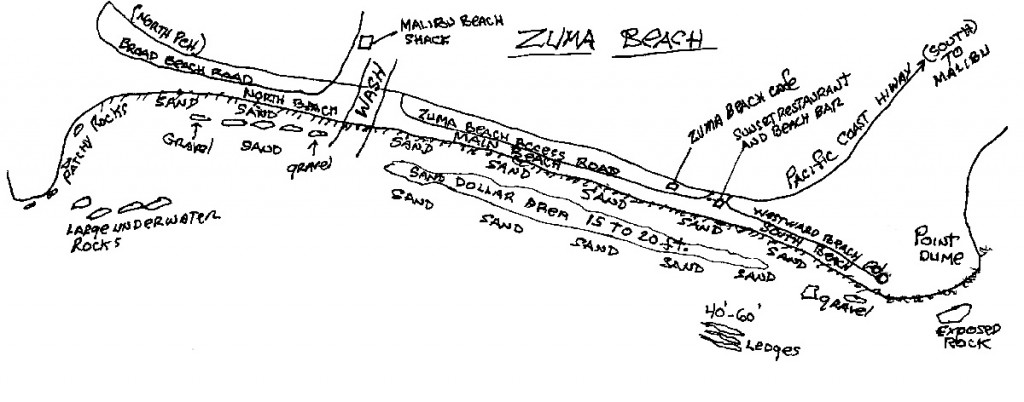ATTENTION!! CLOSURE UPDATE: Effective January 1, 2012, Point Dume north to Encinal Canyon Road will be designated a State Marine Conservation area with special regulations. Just south of Point Dume, Little Dume Cove is also named as a Marine Reserve and is a special closure area. Check the Department of Fish and Game website at http://www.dfg.ca.gov/mlpa/scmpas_list.asp for the new restrictions for these areas.
Zuma Beach is located directly off the Pacific Coast Highway about a thirty minute drive north of Malibu, and it’s one of the best areas to find Pismo clams in Southern California. It’s also a great sun bathing beach in the summer. There’s easy access, lots of convenient parking, and café and grocery facilities nearby. There are two state campgrounds a little further north. The nearest and largest one is Leo Carrillo State Park and the second is Sycamore Canyon (Point Mugu State Park). Both accept reservations, and both have restroom and shower facilities. If you continue north you’ll come to Oxnard and then Ventura where motels are available.
This is a fairly large beach access area, and for that reason I’m going to divide it into three areas for discussion. The north beach includes the area along Broad Beach Road north of the wash (see the map), and that area blends into the main beach which runs from the wash south to the entrance to Zuma Beach Access Road. The south portion continues on from there to Point Dume. All three areas have some different quirks that might appeal to divers searching for Pismo clams or trying to spear the many large halibut that frequent these waters beginning after the first of every year.
 Please note! The surf along this stretch of the coast can be dangerous when there is a large north swell, so always dive safe. Zuma also develops some nasty rip currents when the swells are marching in, so if it looks intimidating to you, don’t dive – wait for a calmer day. It’s a nice beach to hang out, or to have lunch at a nearby café.
Please note! The surf along this stretch of the coast can be dangerous when there is a large north swell, so always dive safe. Zuma also develops some nasty rip currents when the swells are marching in, so if it looks intimidating to you, don’t dive – wait for a calmer day. It’s a nice beach to hang out, or to have lunch at a nearby café.
Main Beach
This area is the best for Pismo clams. I would park anywhere near the middle of the beach to start my dive. It’s a shallow shelving entry over sand, and you may have to work to get past the surf line. Once you’re past the surf line, start your dive immediately. The clams are found anywhere from 10 to 20 feet of water, but I’ve found the inside edge of the sand dollar bed at about 12 to15 feet to be best. You can use your digging tool or rake to poke along, and they’re generally easy to find, but there is a legal take limit to comply with so make sure you know the rules. Sometimes you’ll also see part of a clam shell or spout exposed to make things easier. Most of the clams found here are legal, but you must have a measuring device in your possession, and check your catch when you take a clam. Undersized specimens must be immediately returned to the hole where you found them and buried with the breathing spout up. You can take Pismos year around, but I only take them in the colder water months, those that have an “R” in them. You don’t have to worry about the animals being tainted by red tide then.
I like to tow a float with a game bag attached, usually to the end of the towing line. Also, the towing line should be rigged so that you can adjust it if you increase your depth. Pismos are heavy, so when you’re returning to the beach you can secure your catch to the float for a safer and easier exit.
From January on you’ll often run across halibut lurking about on the bottom, waiting to prey on smaller fish in and around the sand dollars. If that’s something you might be after, secure a spear gun to your float so it can be accessed if you see a legal animal. They usually won’t spook if you back away, anchor your float with the clam bag, and then retrieve your gun and return to the bottom to hunt.
Next week, details on the North Beach area.
